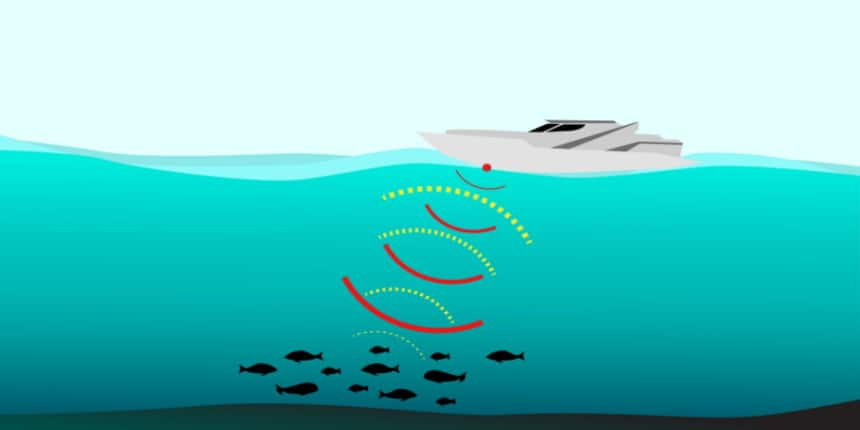Sonar and Radar Full Form
The full form of SONAR is “sound navigation and ranging," and the full form of RADAR is “radio detection and ranging." Both of these devices use the navigation method as well as the detection of various types of properties and characteristics of objects. In essence, the waves are emitted from a source in the direction of the item, hit the object, and then bounce back toward the source, where the detectors detect them. On this basis, the objects' range and distance are calculated. Other than that, both SONAR and RADAR have several uses in various fields like medical, research, traffic control, medicine and in space as well.
This Story also Contains
- What is SONAR?
- Types of SONAR
- What Is RADAR?
- Types of RADAR
- Application of SONAR and RADAR Systems

What is SONAR?
SONAR is a device used by ships and submarines to find the positions of objects in the ocean and uses the propagation method of sound waves. In a regular SONAR system, sound waves of a frequency range of 10 kHz to 50 kHz are used. The sound waves that an object emits or reflects towards the device are then detected by it and further processed for the information they contain.
Types of SONAR
The major classification of SONAR is of three types:
Active SONAR - In an active SONAR system, a target object reflects a sound wave that an acoustic projector emits. The system's receiver collects and analyses the reflected wave to estimate the target object's distance, relative motion, and other parameters.
Passive SONAR − The only component of a passive SONAR system is a receiving system that detects the target object's noise signals and processes them to estimate the target's direction, distance, etc.
Acoustic Communication System − At each end of the acoustic path, the Acoustic Communication System needs a transmitter and a receiver.
What Is RADAR?
The RADAR is a device that uses radio waves to detect various objects, such as aircraft, ships, spacecraft, guided missiles, and weather formations.
A RADAR measures an object's distance, angle, and radial velocity to the site. A transmitter, transmitting antenna, receiving antenna, receiver, and processor make up a standard RADAR system. The transmitter emits electromagnetic waves in the radio or microwave frequency range. The item reflects these electromagnetic waves, which travel back to the receiver and provide information on the object's position and speed. A typical RADAR system has an airborne transmission speed of roughly 3*108 m/s for electromagnetic waves.
Types of RADAR
RADAR is of two types, and based on the signal the system operates:
Pulse RADAR
Continuous Wave RADAR
Pulse RADAR-
In this radar system, the target's range is calculated using pulse-timing methods, and the target object's velocity is calculated using the Doppler effect of the returned signal.
Continuous Wave RADAR-
A continuous wave radio signal with a known constant frequency is delivered by a continuous wave radar (CW radar) and subsequently received by any reflecting objects. The Doppler effect, which makes the received signal have a different frequency from the transmitted signal and enables it to recognize by filtering out the transmitted frequency, can be used to identify individual objects.
Application of SONAR and RADAR Systems
SONAR
For remote sensing, navigation, and communication purposes by underwater submarines.
The military uses the device to track enemies or destroy underwater mines.
Research Work
Industrial and medicinal uses.
RADAR
For weapon control, missile guidance, aircraft navigation, and air traffic controlled by the military.
Used on highways to check for overspeeding vehicles.
It detects satellites and the motion of other celestial bodies.
Used by the meteorological department to check weather conditions.
Frequently Asked Questions (FAQs)
Bat uses the technique of echolocation to find their way.
This technique also measures the depth of the sea or distance of submarines.
This technique is also beneficial in the medical field. Doctors used this phenomenon in cardiography, sonograms, and other medical diagnoses.
It also helps to estimate the distance between hills and mountains.
Although SONAR can be used in air, it is less effective because air is less thick than water, meaning that sound moves more slowly and disappears more quickly.
While moving around different environmental conditions with RADAR is easy, it is less effective underwater. Within a few feet of transmission, large bodies of water absorb the radar's electromagnetic radiation and thus SONAR is used in undersea applications.
1. Active: These are the sound pulses that send and receive echoes. The sound that is thus generated may be in the hearable range of 20 Hz to 20 kHz or higher.
2. Passive: These devices merely receive echoes and make no transmissions.
Both devices operate on the same principle of echo-detecting transmitted waves.
SONAR stands for Sound Navigation Ranging and works on the principle of echoes. In contrast, RADAR stands for Radio Detection and Ranging and transmits radio signals into the system, which return to the object and are picked up by it. The receiver then amplifies it to show the target's range and direction.